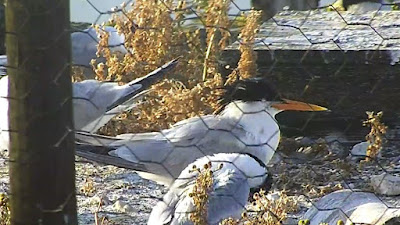I'm sharing this with though because it's quite an exciting bird: a spotted flycatcher. These birds are summer visitors to the UK and are in decline. Fortunately for me the New Forest is one of the best places to see these birds. They are fairly drab looking but it's their fly-catching which is great to watch. They fly from a high perch, dash out to catch a fly and then return to the same spot. That's exactly what this individual was doing at this moment.
On the same New Forest visit I was delighted to stumble across this enormous fungus.
It's by far the largest fungus I've ever seen and is a puffball, probably even a mosaic puffball. It's a magnificent specimen.
Via the Brownsea Island Lagoon webcam, I was able to observe an even more unusual bird this week, an elegant tern.
This species breeds on the the Pacific coast on America yet occasionally terns up (pun intended) here in the UK. This one was around the lagoon all day and eventually roosted there. I think terns are magnificent birds anyway but this species with it's incredible spiky crown is really something. Thanks to the webcam I could watch it from the comfort of the sofa too!
Over the last few weeks I've seen a lot of house sparrows fledglings in the garden, always squawking and flapping their wings for food. Usually the parents are quick to oblige.
I've noticed that there have been egyptian geese on the fishing lake regularly over the last week or so, likely taking shelter from the high temperatures.
As the name suggests, these species are not native to the UK. They were introduced as ornamental birds but as often happens some escaped and are now living wild. The main population in the UK is in Norfolk but we have a growing population here in Ringwood thanks to the various former gravel pits which are now lakes.
One final bird today is the Avon grey heron which I have often shared here. This though is perhaps the best photo of it yet.
There's still been plenty of interesting invertebrates around. Here's a particularly fine example of a dock bug and below that a relative, forest bug.
I got some great views of some of my local butterflies yesterday, like meadow browns and commas.
I was really excited to stumble across a less familiar species too, a large skipper.
This butterfly likes long grass so it made sense to find it on my favourite insect path. The path is narrow at the best of times and not used very much but in summer it becomes really overgrown and the insects take over. Every time I venture down it I come across something new.
Speaking of which, I also spotted an unusual moth species along the path yesterday, white speck.
Also a grass feeder, this moth is more commonly found in Southern Europe but it's a migrant and has likely flown North to the UK thanks to the recent warm weather.
I've shown you a few cinnabar moths over recent weeks so I knew it was only a matter of time before I found some of the species' distinctive caterpillars.
These caterpillars hatch in huge numbers on ragwort plants. Ragwort is poisonous and is often removed from fields so that horses don't eat it. It's vitally important to cinnabars though and actually the caterpillars can be used to control the plant. The caterpillars end up becoming poisonous thanks to eating the plant but some species do predate them like some ants and cuckoos.
Speaking of cuckoos, I regularly look at the BTO's Cuckoo tracking scheme. The organisation has tagged and is tracking cuckoos as they migrate to and from Africa. Of particular interest to me is Selborne, a cuckoo who was tagged in and returns to the New Forest. He arrived back in the New Forest on Easter Sunday and spent less than two months here- he's now heading back South and is near Bilbao!
One final invertebrate to end, and it's the wonderfully named swollen-thighed beetle on a field scabious flower.
That's it for now so I shall see you in July!


















No comments:
Post a Comment